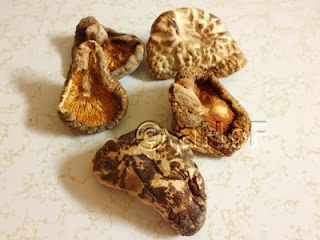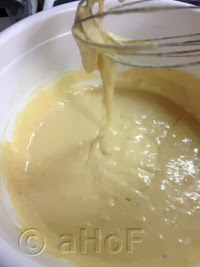 |
| lines showing how to slice across the grain |
 |
| julienned carrots |
 |
| My Dried Keffir Lime Leaves |
 |
| Dried Shiitake Mushrooms |
The recipe turned out very well, overall. The flavors were great and everything cooked just as I wanted, meaning nothing was too overcooked. I believe that Thai flavors are not really my preferred flavors. While the meal was truly delicious, had it been an Indian Curry, I would have loved it far more. I just love some of the warm Indian spices more than Thai flavors. Regardless, I may be in a great minority on that, so do not let that stop anyone from trying this dish. It really was wonderful.
Thai Green Curried Chicken
Serves 4 to 6
2 pounds skinless, boneless chicken breast (about 4), partially frozen
 |
| Thai Green Curried Chicken |
3 tablespoons soy sauce
4 dried Shiitake mushrooms
2 teaspoons coconut oil
1 onion, in wedges or cubes
4 - 8 tablespoons Thai Green Curry Paste
1 can coconut milk (not sweetened)
2 carrots, peeled, julienned
1 green or red bell pepper, cut in cubes
2 - 4 Thai chilies, optional
3 cloves garlic, minced finely
3 - 4 tablespoons fresh ginger, minced finely
2 Keffir lime leaves, or 1 - 2 teaspoons lime zest
fresh cilantro leaves, as garnish
roasted cashews for garnish
Slice the chicken across the grain of the meat, into thin slices. Set them into a bowl and toss with the soy sauce. Set the Shiitake mushrooms to soak in about 1 1/2 cups boiled water. Cover and allow them to reconstitute for at least 20 minutes. Heat the coconut oil in a very large skillet or wok and cook the chicken, about half the pieces at a time. They need only be partially cooked. Removed them to a plate when done. Add the onions to the skillet and saute them for about 3 to 4 minutes. Add in the Thai Green Curry Paste and stir until fragrant, about 1 to 2 minutes. Add in the coconut milk and stir to combine. Add in the vegetables, garlic and ginger with the lime leaves and return the chicken to the skillet. Stir together carefully and allow to simmer for 15 to 20 minutes, stirring occasionally. Garnish with cilantro leaves and cashews. Best served over white rice.
My passion is teaching people how to create a harmony of flavors with their cooking, and passing along my love and joy of food, both simple or exotic, plain or fancy. I continue my journey in ethnic and domestic cuisines, continuing my journey to explore diverse culinary experiences and hopefully to start you on a journey of your own. Join me also at A Harmony of Flavors on Facebook, and Pinterest.



































